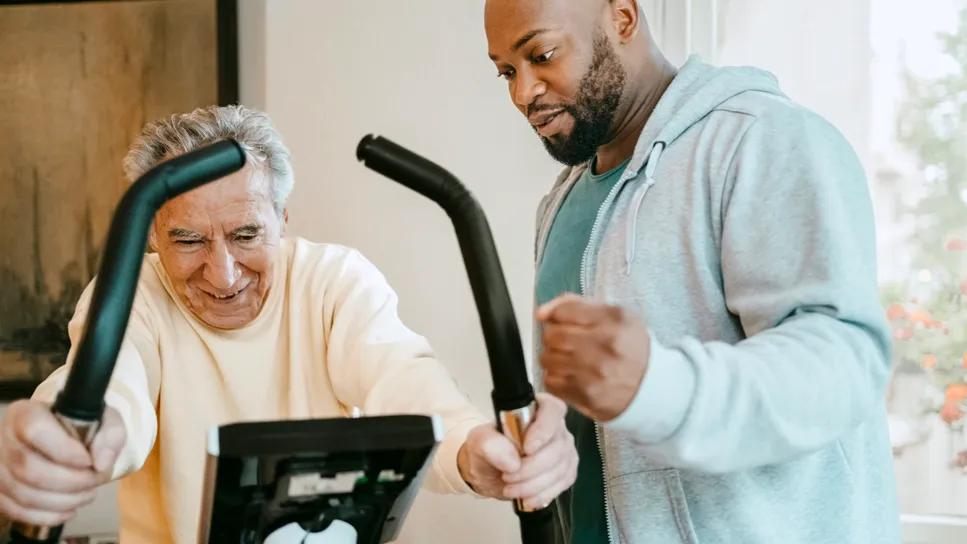Cleveland Clinic researchers awarded $3.2 million for first-of-its-kind investigation

New Cleveland Clinic research will gather data derived from deep brain stimulation (DBS) devices to study neural mechanisms underlying the benefits of aerobic exercise in people with advanced Parkinson’s disease (PD).
Advertisement
Cleveland Clinic is a non-profit academic medical center. Advertising on our site helps support our mission. We do not endorse non-Cleveland Clinic products or services. Policy
The study, led by Jay Alberts, PhD, Vice Chair of Innovation at Cleveland Clinic’s Neurological Institute and Staff, Biomedical Engineering, has been awarded a five-year, $3.2 million grant from the National Institutes of Health. It expands upon the Alberts lab's seminal tandem cycling study, which established the positive effects of aerobic exercise on motor, memory and cognitive processing symptoms in those with PD.
“This will be the first study I'm aware of to look at a relatively long-term exercise intervention for patients with deep brain stimulation,” says Dr. Alberts. “It has the potential to transform our understanding of Parkinson's disease as well as our general understanding of the impact of exercise on brain function. That knowledge could be extended to individuals who do not have Parkinson's disease. And anything we can do to better understand that, to help facilitate and potentially motivate individuals from an exercise perspective, would be impactful.”
Broadly, the study focus will be on two areas of inquiry:
“Results will provide insight into what exercise is doing, from a neural perspective, to the area of the brain affected by Parkinson's disease,” says Dr. Alberts. “We know exercise helps symptoms, but now we'll actually be able to see and understand the mechanism underlying those improvements.
Advertisement
“Once we understand the mechanism, then we may be able to develop therapeutics to replicate the positive effects,” he adds. “So instead of searching for the elusive ‘exercise pill,’ we may be able to create exercise DBS parameters.”
Participants will be enrolled in an eight-week exercise cycling program. They will be randomized to either a voluntary (VE) program or a forced exercise (FE) program.
The VE group will exercise at a cadence of 60 rpms or fewer; the FE group will exercise on a motorized cycle that augments the participants’ self-selected pace to 80-90 rpms.
“We do not focus too much on heart rate with PD patients because they experience chronotropic incompetence, which can make it difficult for them to reach a target heart right,” Dr. Alberts explains. “Heart rate is affected by pain, dehydration, sleep and other factors, and PD patients may have any of those issues. We previously found that a more important predictor of a positive outcome with exercise is power, or the watts produced during the exercise, because it is a direct measure of work performed.”
Both groups will exercise three times a week for the eight weeks. Their DBS device will gather neural activity data from the subthalamic nucleus (STN) and EEG will record cerebral cortex data. Together these data will aid in identifying neural mechanisms associated with PD symptom improvements after long-term aerobic exercise.
Assessments will be made at baseline, end of treatment and four weeks after the end of treatment for motor, cognitive and dual-task function as well as underlying cortical and subcortical neural data.
Advertisement
The cortico-basal ganglia-thalamic (CBGT) loop is a neural circuit key to controlling movement, motor learning, decision-making and short-term memory. Its dysregulation is associated with Parkinson's disease and other conditions. The researchers hypothesize that long-term aerobic exercise normalizes CBGT activity by reducing beta oscillations in the STN. Reduced STN beta oscillations lead to improvements in motor, cognitive and dual-task performance.
Analyzing STN and cerebral cortex data before and after long-term exercise is expected to yield unprecedented insight into neural mechanisms underlying the positive effects of exercise.
In addition to the novel direction of the study, Dr. Alberts says it’s notable that existing “off-the-shelf” technology (Medtronic Percept DBS system) will be used to provide insight into exercise mechanisms. And because two modes of exercise will be studied (VE v. FE), the research should yield insights which mode is better or whether there is a superior mode for certain individuals.
Advertisement
Advertisement

Large NIH-funded investigation is exploring this understudied phenomenon

Advances in genomics, spinal fluid analysis, wearable-based patient monitoring and more

Case study of radial-to-axillary nerve transfer for tumor-related deltoid nerve injury

An update on the technology from the busiest Gamma Knife center in the Americas

Real-time adjustments may help reduce bothersome dyskinesias

Anatomical modeling can identify optimal surgical candidates, study suggests

Add AI to the list of tools expected to advance care for pain patients

New guidelines from Brain Trauma Foundation urge early and aggressive treatment